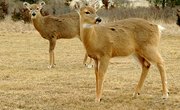
A Native Americans saying goes, "Every animal has just enough brains to tan its own hide." This refers to each species of animal having just the right amount of brain matter to soften and preserve its hide. While commercial processors use chemicals, many traditionalists will argue that brain tanning returns superior results when making a rug from coyote hide. This is due to brain matter containing enzymes that effectively break down the collagen fibers in the skin - without the use of toxic chemicals.
Items you will need
Fleshing or draw knife
Shampoo
4-inch wide beam
2 cups brain matter (cow or sheep)
Water
Blender
Plastic trash bag
Nylon rope
Lay the hide, fur side down, across the fleshing beam. Straddle the beam with your legs, pinning the sides of the hide against the beam with your knees. Scrape all areas of the skin with the fleshing knife, removing all traces of flesh and membrane. Continue to scrape the hide until the surface becomes dull and smooth, and is no longer slippery to the touch.
Wet the hide thoroughly with lukewarm water. Add just enough shampoo to achieve a light lather and wash both sides of the hide thoroughly to remove all traces of blood and dirt. Rinse the pelt thoroughly with plain water. Hang the hide up to dry. Do not place the hide in the sun.
Add 2 cups brain matter to the blender. Cover the brains with warm water
(approximately 120 degrees). Set the blender to the highest setting. Add water while mixing until the brain matter is reduced to the consistency of paste.
Rub the brain mixture into both sides of the hide with your fingers. Roll up the hide and place it in a plastic bag. Place the bag out of the sun for three hours. Cover the unused brain matter.
Remove the hide from the plastic bag and work the hide through your fingers. If the skin is not soft and pliable, work more brain matter into the hide and return to the bag for two more hours.
Wipe as much brain mixture as possible from the hide with a damp rag. Hang the hide out of the sun. Allow the hide to partially dry, until damp to the touch. Do not allow the hide to dry to the point of becoming stiff or it will become extremely difficult to work with.
Stretch a rope between two objects, such as trees or fence posts. Drape the hide over the rope. Hold the hide with one hand on each side of the rope and rub the bare skin side of the hide in a back-and forth motion across the rope. Work only the bare side of the hide as rubbing the fur will break the hair. The more you work the hide the softer the skin will become as rubbing the hide breaks down the collagen fibers. The friction generated by rubbing the hide against the rope will dry the hide.
Warnings
- Due to concerns of transmission of rabies do not use the brains of carnivores for brain tanning. Instead secure the brain matter of animals such as cows or sheep from local supermarkets.
Tips
- Trim a piece of felt to the shape of the hide, but make the felt outline approximately 1-inch larger than the pelt. Sew the felt in place, to the bottom of the hide, to create a decorative border.
References
- Buckskin: The Ancient Art of Braintanning: Steven Edholm and Tamara Wilder: 2001
Tips
- Trim a piece of felt to the shape of the hide, but make the felt outline approximately 1-inch larger than the pelt. Sew the felt in place, to the bottom of the hide, to create a decorative border.
Warnings
- Due to concerns of transmission of rabies do not use the brains of carnivores for brain tanning. Instead secure the brain matter of animals such as cows or sheep from local supermarkets.



